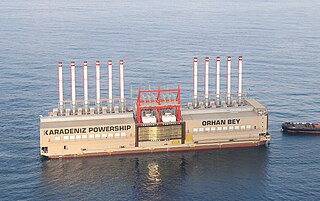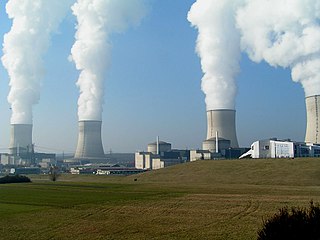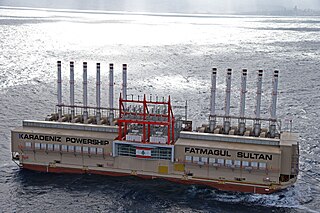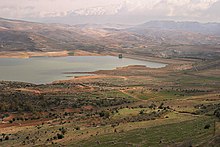
Electricity generation is the process of generating electric power from sources of primary energy. For utilities in the electric power industry, it is the stage prior to its delivery to end users or its storage.

Many countries and territories have installed significant solar power capacity into their electrical grids to supplement or provide an alternative to conventional energy sources. Solar power plants use one of two technologies:

Solar power is the conversion of energy from sunlight into electricity, either directly using photovoltaics (PV) or indirectly using concentrated solar power. Photovoltaic cells convert light into an electric current using the photovoltaic effect. Concentrated solar power systems use lenses or mirrors and solar tracking systems to focus a large area of sunlight to a hot spot, often to drive a steam turbine.

As of April 2020, the energy sector in Senegal has an installed capacity of 1431 megawatts (MW). Energy is produced by private operators and sold to the Senelec energy corporation. According to a 2020 report by the International Energy Agency, Senegal had nearly 70% of the country connected to the national grid. Current government strategies for electrification include investments in off-grid solar and connection to the grid.
Between 1992 and 2022, the worldwide usage of photovoltaics (PV) increased exponentially. During this period, it evolved from a niche market of small-scale applications to a mainstream electricity source.

A powership is a special purpose ship, on which a power plant is installed to serve as a power generation resource.

The electricity sector in France is dominated by its nuclear power, which accounted for 71.7% of total production in 2018, while renewables and fossil fuels accounted for 21.3% and 7.1%, respectively. France has the largest share of nuclear electricity in the world, and together with renewable energy supplies, this has helped its grid achieve very low carbon intensity.

The electricity sector in Switzerland relies mainly on hydroelectricity, since the Alps cover almost two-thirds of the country's land mass, providing many large mountain lakes and artificial reservoirs suited for hydro power. In addition, the water masses drained from the Swiss Alps are intensively used by run-of-the-river hydroelectricity (ROR). With 9,052 kWh per person in 2008, the country's electricity consumption is relatively high and was 22% above the European Union's average.

Energy in Jordan describes energy and electricity production, consumption and import in Jordan. Jordan is among the highest in the world in dependency on foreign energy sources, with 96% of the country's energy needs coming from imported oil and natural gas from neighboring Middle Eastern countries. This complete reliance on foreign oil imports consumes a significant amount of Jordan's GDP. This led the country to plan investments of $15 billion in renewable and nuclear energy. To further address these problems, the National Energy Strategy for 2007-2020 was created which projects to boost reliance on domestic energy sources from 4 per cent to 40 per cent by the end of the decade.

As of the end of 2014, solar power in Austria amounted to 766 megawatt (MW) of cumulative photovoltaic (PV) capacity, of which more than three quarters were installed within the last four years. Solar PV generated 766 gigawatt-hours, or about 1.4% of the country's final electricity consumption. As with most other European countries, 99.5 percent of all solar power systems are connected to the electrical grid. The nation's installed PV capacity by inhabitant stood at 91 watts, still below the European Union's 2014-average of 172 watts.

Solar power in France including overseas territories reached an installed capacity figure of 11.2 GW by the end of 2020.
Under its commitment to the EU renewable energy directive of 2009, France has a target of producing 23% of its total energy needs from renewable energy by 2020. This figure breaks down to renewable energy providing 33% of energy used in the heating and cooling sector, 27% of the electricity sector and 10.5% in the transport sector. By the end of 2014, 14.3% of France's total energy requirements came from renewable energy, a rise from 9.6% in 2005.

The MV Karadeniz Powership Esra Sultan is a Powership, a floating power plant, owned and operated by Karpowership. Built in 2007, it was converted into a Powership in 2015 by Sedef Shipyard in Tuzla, Istanbul, Turkey. She was commissioned to supply electricity to the power grid in Ghana. Currently, she serves in Dakar, Sénégal.

The MV Karadeniz Powership İrem Sultan is a Liberia-flagged Powership, a floating power plant, owned and operated by Karpowership. Built in 1984 by the Fincantieri Marghera Shipyard in Venice, Italy and christened MV Nikolay Markin, she sailed as a barge carrier under various names and flags until in 2014 she was converted into a powership at the Sedef Shipyard in Tuzla, Istanbul, Turkey. She served in Nacala, Mozambique supplying electricity to Mozambique's power grid for land-locked Zambia. Currently, she serves in the dominican Republic and is stationed in Santo Domingo.
Myanmar had a total primary energy supply (TPES) of 16.57 Mtoe in 2013. Electricity consumption was 8.71 TWh. 65% of the primary energy supply consists of biomass energy, used almost exclusively (97%) in the residential sector. Myanmar’s energy consumption per capita is one of the lowest in Southeast Asia due to the low electrification rate and a widespread poverty. An estimated 65% of the population is not connected to the national grid. Energy consumption is growing rapidly, however, with an average annual growth rate of 3.3% from 2000 to 2007.

The MV Karadeniz Powership Fatmagül Sultan is a Liberia-flagged Powership, a floating power plant, owned and operated by Karpowership. Built as a barge, she was converted into a Powership in 2013 at Sedef Shipyard in Tuzla, Istanbul, Turkey. She is commissioned to supply electricity to the power grid in Lebanon.

The MV MV Karadeniz Powership Orhan Bey is a power barge, a floating power plant, owned and operated by Karpowership. She was commissioned in 2013, and initially contracted to supply electricity to the power grid in Lebanon.
Karpowership is a Turkish builder, operator, and owner of a fleet of powerships. Since 2010, 36 powerships have been completed with their total installed capacity exceeding 6,000 MW, with a further 6,000 MW capacity under construction.

Électricité du Liban is a public industrial and commercial establishment in Lebanon which controls 90% of the country's electricity production, transmission and distribution activities.

















